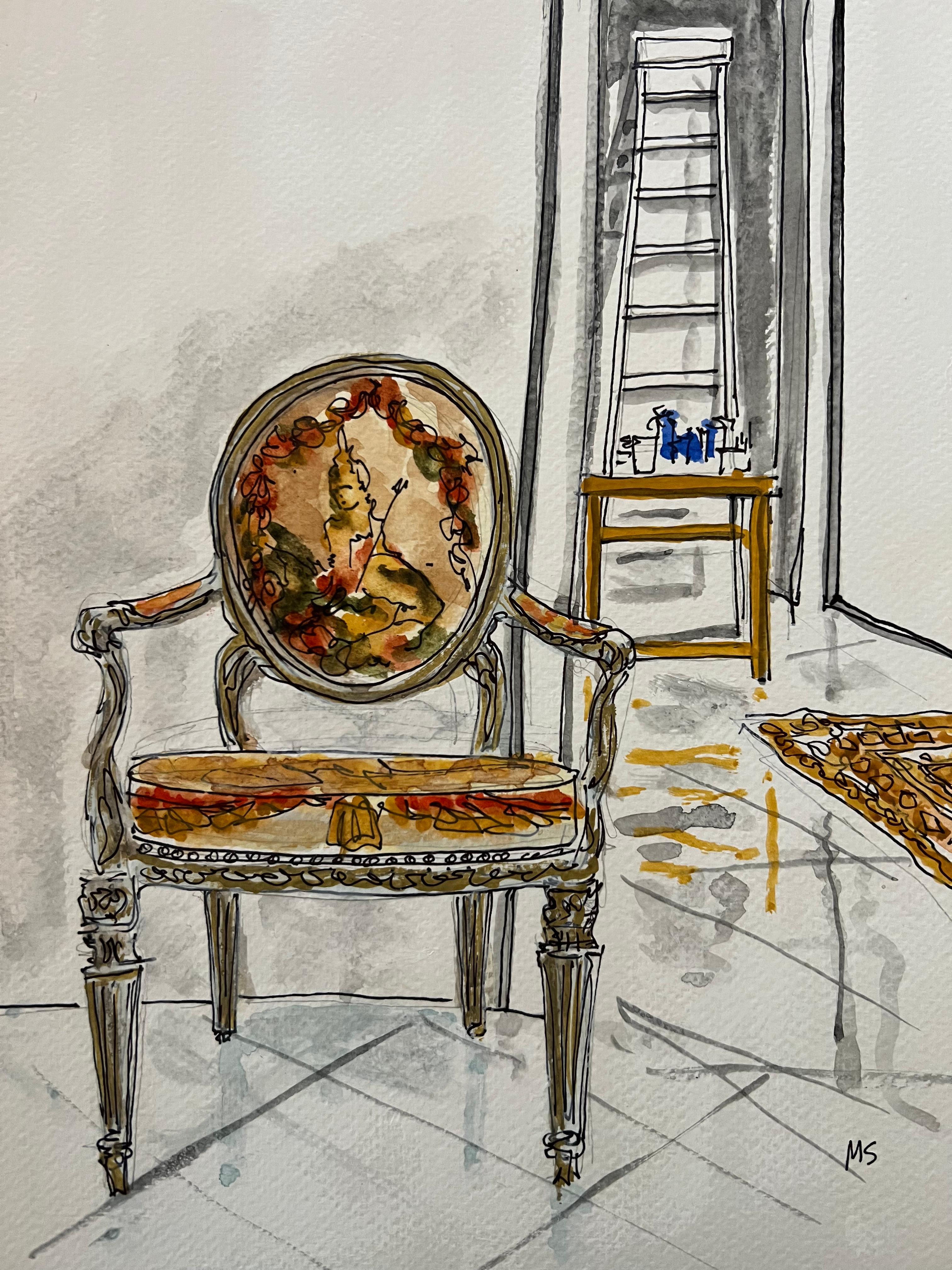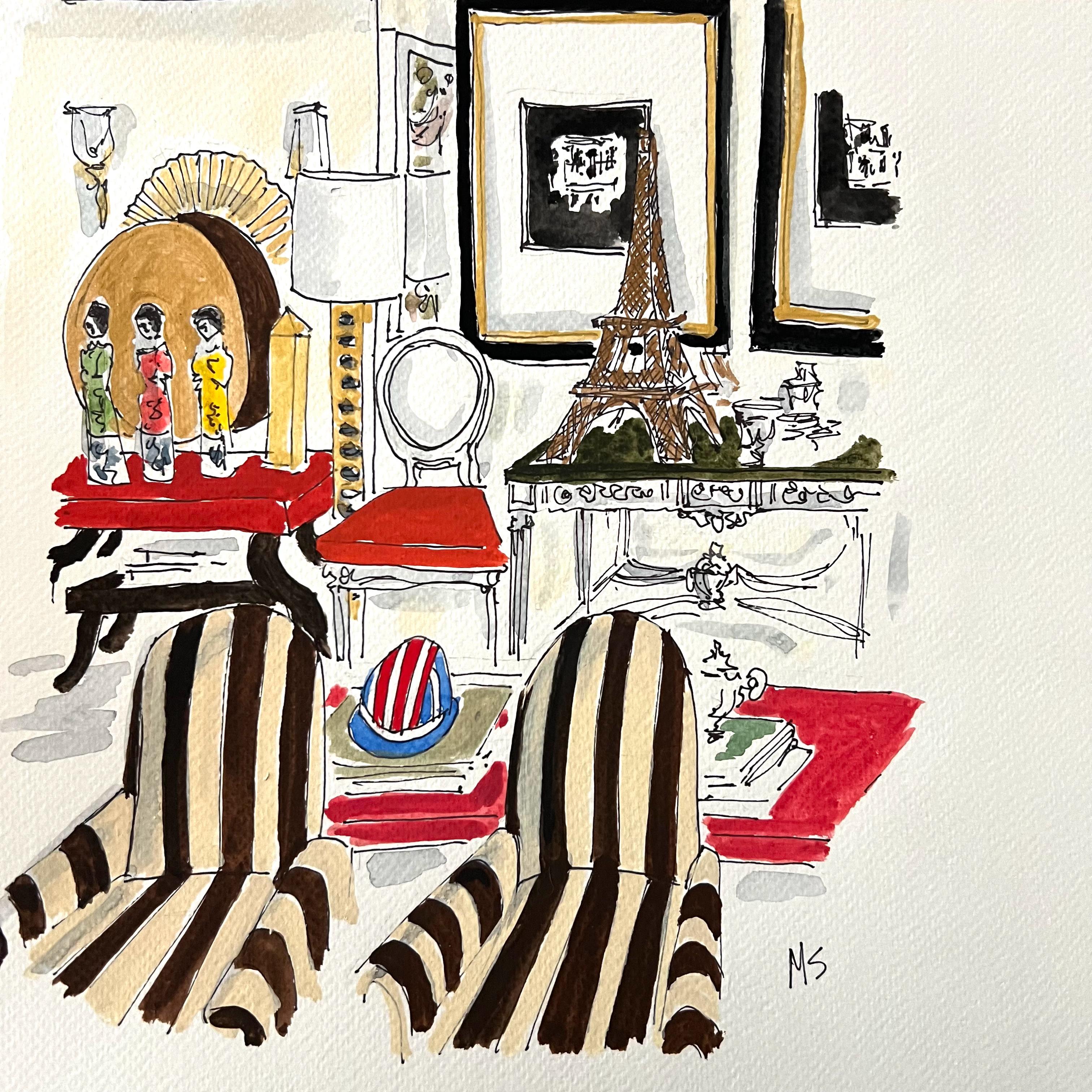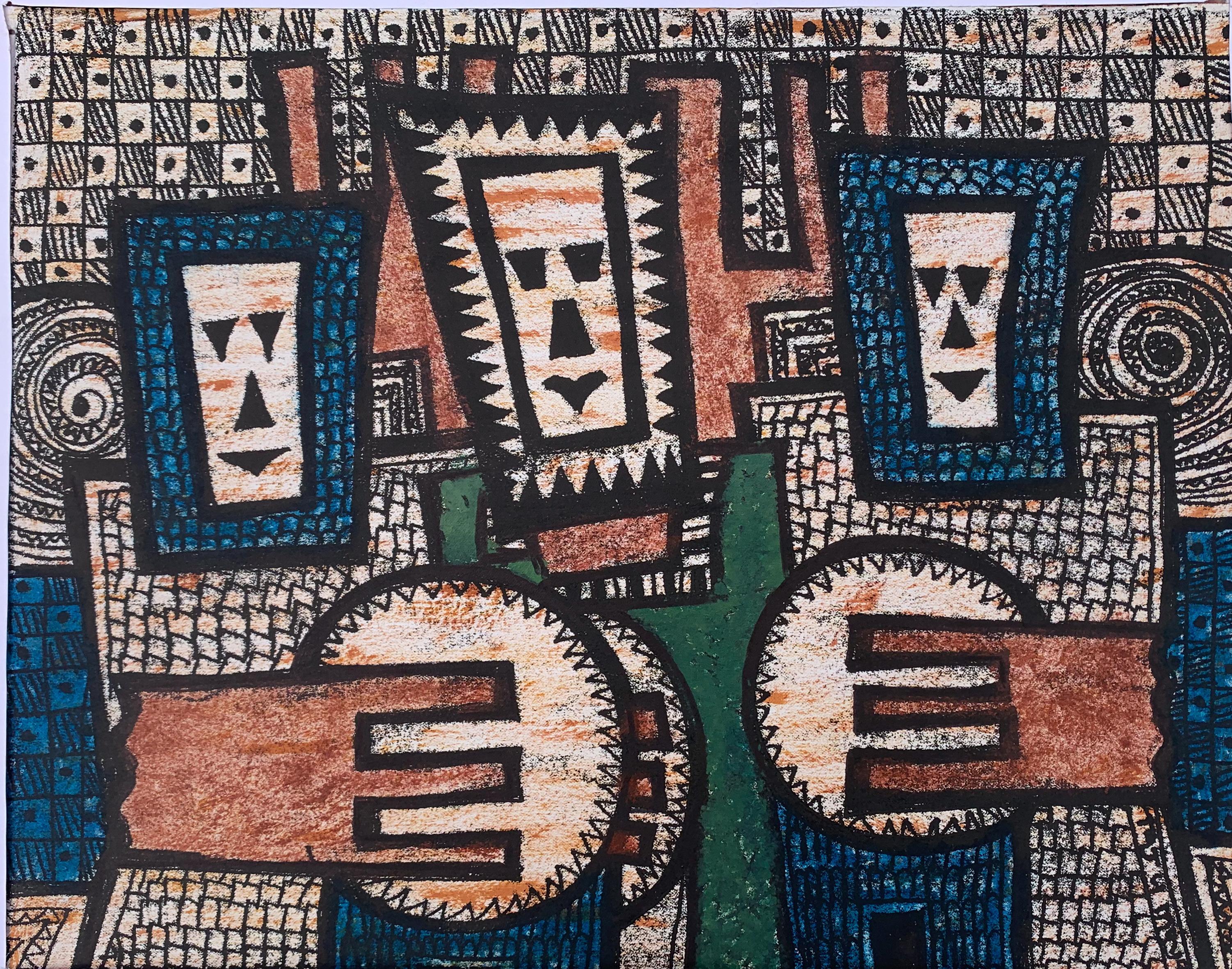Items Similar to Baroque Interior, a drawing attributed to Francesco Battaglioli (1725 - 1796)
Want more images or videos?
Request additional images or videos from the seller
1 of 6
Baroque Interior, a drawing attributed to Francesco Battaglioli (1725 - 1796)
About the Item
The technique of this luminous architectural drawing with its rigorous perspective is perfectly representative of the creations of the Venetian school’s 18th century vedutists. Similar drawings support its attribution to Francesco Battaglioli.
Iron gall ink and grey ink wash on paper
13 3/8 “ x 8 7/8 “ (34 x 22.5 cm)
We wish to thank Mrs Bożena Anna Kowalczyk who suggested the attribution to Francesco Battaglioli based on a photograph of the artwork.
1. Francesco Battaglioli
Little is known about the life of Francesco Battaglioli. Born in Modena in 1725, where he probably did his apprenticeship, he was admitted around 1750 to the Fraglia, the Venetian painters' guild.
A painter of vedute and caprice, he also participated in the decoration of operas, in particular during a stay in Spain from 1754 to 1760 as stage painter to Ferdinand VI. It was during this stay that the famous castrato Carlo Broschi, known as Farinelli, commissioned him to paint a series of canvases to immortalise the most famous operas performed in the Royal Coliseum of the Buen Retiro in front of Ferdinand VI and Barbara de Braganza. Several canvases from this series are preserved at the Royal Academy of Fine Arts in San Fernando, in the Prado in Madrid, and at the Garnier Opera House in Paris.
Battaglioli became a member of the Academy of Fine Arts in Venice in 1772 and succeeded Antonio Visentini (1688 - 1782) as professor of perspective in 1778.
Our drawing is very close in style to two drawings signed by Battaglioli: one is in the collection of the Albertina in Vienna, while the other was sold in 2009 at Karl & Faber in Munich.
2. Description of the artwork
Like an opera set, our drawing is organised in successive planes which take our eyes through a vast baroque styled building. In the foreground on the left stand two columns, then we see a first space delimited by a wall decorated with two niches containing a statue and a rococo urn. This space opens up through a semi-circular arch into a third monumental hall bordered by a colonnade and covered by a frescoed vault. It is difficult to establish whether we are in a sacred or a secular interior: the presence of statues might suggest that we are in a church, whereas the final opening, through a new arch, onto a landscape evokes a grand ballroom.
The rigorous perspective is very similar to drawings made with a camera obscura. However, the landscape in the background suggests that this is probably an architectural capriccio, perhaps inspired by a real building. The lines drawn on the ground guide our eyes along the perspective. The modulation of the light, rendered by the grey ink wash brings life to this entirely mineral world.
The drawing is sold unframed but we have presented in the gallery a framing option whose price is available upon request.
- Attributed to:Francesco Battaglioli (1725 - 1796, Italian)
- Dimensions:Height: 13.38 in (33.99 cm)Width: 8.88 in (22.56 cm)
- Medium:
- Movement & Style:
- Period:
- Framing:Framing Options Available
- Condition:Iron gall ink and grey ink wash on paper 13 3/8 “ x 8 7/8 “ (34 x 22.5 cm) We thank Mrs Bożena Anna Kowalczyk who suggested the attribution to Francesco Battaglioli.
- Gallery Location:PARIS, FR
- Reference Number:1stDibs: LU1568210174382
About the Seller
5.0
Vetted Seller
These experienced sellers undergo a comprehensive evaluation by our team of in-house experts.
Established in 2020
1stDibs seller since 2021
8 sales on 1stDibs
Typical response time: 2 hours
- ShippingRetrieving quote...Ships From: PARIS, France
- Return PolicyA return for this item may be initiated within 3 days of delivery.
More From This SellerView All
- Baroque silver Vase with Flowers with a Fruit Tray and a Clock by A. ZuccatiLocated in PARIS, FRThis unpublished composition is a recent addition to Adeodato Zuccati’s catalog. The study of this painting by Gianluca Bocchi, an Italian art historian specializing in Italian still lives, is available upon request. This composition is typical of the productions of Adeodato Zuccati, an Emilian painter...Category
Late 17th Century Old Masters Still-life Paintings
MaterialsCanvas, Oil
- Still Life with Herring, a panel by the workshop of Georg Flegel (1566 - 1638)Located in PARIS, FRFred G. Meier, art historian, confirmed with the following comment, after a photographic examination of the work, that it belongs to the studio of Georg Flegel...Category
1630s Old Masters Still-life Paintings
MaterialsOak, Oil
- Landscape with Trees and a Fisherman walking, a drawing by Jan Van GoyenBy Jan Josefsz Van GoyenLocated in PARIS, FRNo Dutch draughtsman ever captured the atmosphere of the rural countryside of Holland with the same atmospheric and engaging simplicity that Van Goyen achieved in drawings such as this. Indeed, his landscapes were seminal in the development of the genre. The present sketch conveys a striking sense of movement within the natural landscape, conveyed by the deftly applied strokes of chalk, from which the artist’s hand can be sensed. The composition is characteristic of his work, with the low horizon affording significance to the broad sky and the soaring birds within. This feeling of windswept motion powerfully evokes the expansive Dutch farmland with which he was evidently preoccupied. 1. Jan van Goyen...Category
1650s Old Masters Landscape Drawings and Watercolors
MaterialsChalk, Ink, Laid Paper
- Italian Landscape, a drawing by Louis-Jean Desprez (1743 - 1804)Located in PARIS, FRThis landscape, masterfully executed in pen and wash by Louis-Jean Desprez around 1779, probably represents a view of the Roman countryside. The treatment of the trees is very similar to that of two engravings which Desprez executed in Rome, The Island of Cythera and The Temple of Love. 1. Louis-Jean Desprez, a cosmopolitan life between Italy and Sweden Born in Auxerre in 1743, Louis-Jean Desprez probably began his apprenticeship with the engraver Charles-Nicolas Cochin...Category
1770s Old Masters Landscape Drawings and Watercolors
MaterialsCarbon Pencil, Ink
- Modello for the Virgin of the Rosary, a drawing by Francesco Vanni (1563 - 1610)Located in PARIS, FRFrancesco Vanni is one of the last representatives of the long Sienese pictorial tradition. In this masterly composition in pen and ink wash, he presents the Virgin of the Rosary, holding the Child Jesus on her lap, surrounded on her right by Saint Dominic and on her left by Saint Catherine of Siena. The presence of these two emblematic saints of the Dominican order is a reminder of the devotion of this order to the Rosary. 1. Francesco Vanni, a Sienese painter of the Counter-Reformation Francesco Vanni was the most important Sienese painter of the late sixteenth century and a key Italian Counter-Reformation painter. He developed a very specific style, inspired not by Florentine models but rather by the Roman, Bolognese and Marche schools, and in particular by the work of his contemporary Federico Barocci (Urbino 1535 - 1612), despite the two artists never meeting. Francesco Vanni was born in Siena around 1563-1564. His father died in 1567 and his mother remarried Arcangelo Salimbeni (1536 - 1579), then one of Siena’s leading painters. His half-brother Ventura Salembini (1568 - 1613) also became a well-known painter. He continued his apprenticeship in Bologna and Rome, where he joined the painter Giovanni de Vecchi’s (1536 - 1614) studio, where he was greatly influenced, like other Tuscan painters of the time, by the art of Federico Barocci. He devoted himself mainly to religious painting, following the canons of the Counter-Reformation. Travelling between Siena, Rome, Bologna and Parma, in 1604, he settled in Siena, where he ended his life. Vanni was also an important member of the Confraternity of the Sacro Chiodo, renowned for its demanding religious practices. His legacy also includes some important engraved work. 2. Description of the artwork The Virgin is depicted enthroned in majesty, slightly taller than the other figures that she dominates from her pedestal. Her wide robe with marked folds evokes Renaissance statuary. She is crowned by two angels in the sky. These two angels are a reminder of the custom of adding angels to crown 13th century icons which was frequent at Vanni’s time. The Child Jesus is standing on the Virgin’s right knee. With her left hand she holds out a rosary to Catherine of Siena, identifiable by a branch of lily in her hand. In a symmetrical gesture, the Child Jesus also holds out a rosary to St Dominic. Two of St Dominic’s attributes are to be found at the foot of the Virgin: a book and a branch of lilies. Vanni gives particularly delicate treatment to St. Dominic's long and slender hands. The two outstretched rosaries form the link between the heavenly register of the Virgin and the Child Jesus and the earthly register of the two Dominicans who are not crowned with a halo. This and the fact they are followed by a large crowd, indicates that they are both represented as part of the multitude of the living called to pray to the Rosary. According to the classical iconographic tradition, it would be plausible to consider that the figure looking at the viewer on the extreme left of the drawing could be a self-portrait of the painter. Francesco Vanni's face is known to us from a self-portrait kept in the Pinacoteca Nazionale in Siena. The squaring of the drawing suggests that it was used for a larger-scale altarpiece, probably for a church dedicated to St Dominic or for a Dominican convent. As of today, we have not identified the painting for which this drawing served as a preparatory modello. The Madonna of the Rosary in the Cathedral of Pitigliano (painted by Francesco Vanni in 1609) differs quite significantly from our drawing by the addition of Pope Pius V, and the inclusion of St. Dominic and St. Catherine in the celestial register. We believe that our drawing predates this painting because of its more symmetrical composition, and less Baroque influence. The presence of Saint Catherine of Siena, particularly venerated in his native town, to which Francesco Vanni returned frequently from 1590 onwards, leads us to propose a date of around 1590 - 1600 for this drawing. 3. The Rosary and the Dominican Order In order to clarify the iconographic meaning of this artwork, it is worth recalling the role of Saint Dominic in the spread of the Rosary prayer. Dominic Nuñez de Guzman was born around 1170 in Caleruega (near Burgos) in Spain and died in 1221 in Bologna, Italy. He was the founder of the order of friar preachers, commonly known as the Dominicans. He was canonised by the Church in 1234 and has since been celebrated under the name of Saint Dominic. After three days of prayer in the forest of Bouconne, near Toulouse, Dominic is said to have received the Rosary as a means of converting the Cathar population. The Dominicans subsequently made a special effort to promote this form of meditative prayer. Pope Pius V, a Dominican, included the feast of the Rosary (on October 7th) in the liturgical calendar in 1571. Rosary prayer has evolved over the centuries and traditionally consists of the recitation of three rosaries (four since St John Paul II). Each rosary consists of five tens of "Hail Mary...Category
16th Century Old Masters Figurative Drawings and Watercolors
MaterialsPen, Ink
- Pavilion with waterfall, an ink wash attributed to Hubert Robert (1733 - 1808)By Hubert RobertLocated in PARIS, FRThis large wash drawing is a slightly enlarged version of a composition executed by Hubert Robert in 1761, at the end of his stay in Rome. This composition is a marvellous synthesis of the painter's art: the clatter of the waterfall, in a grandiose setting inspired by antiquity, is opposed to the intimacy of a genre scene, made up of a few peasant women performing some agricultural work. 1. The stay in Italy, an important founding stage in Hubert Robert's carrier Hubert Robert came from a privileged family of Lorraine origin, linked to the Choiseul-Stainville family, where his father was an intendant. The protection of this powerful aristocratic family enabled him to study classical art at the Collège de Navarre (between 1745 and 1751). After a first apprenticeship in the workshop of the sculptor Slodtz (1705 - 1764), he was invited by Etienne-François de Choiseul-Beaupré-Stainville (the future Duke of Choiseul, then Count of Stainville) to join him in Rome when the latter had just been appointed ambassador. Hubert Robert arrived in Rome on 4 November 1754, aged twenty-one, and remained there until 24 July 1765. Thanks to his patron, he obtained a place as a pensioneer at the Académie de France without having won the prestigious Prix de Rome. On his arrival in Rome, he frequented the studio of the painter Giovanni Paolo Panini (1691 - 1765), the inventor of the ruins painting, and also benefited from the proximity of Giovanni Battista Piranesi’s studio (1720 - 1778). During his eleven-year stay in Rome, Hubert Robert studied the great Italian masters and drew many of the great archaeological sites, multiplying the sketches which he would use throughout his career, becoming one of the masters of the "ruin landscape". Back in Paris in 1765, he was very successful. He was accepted and admitted to the Royal Academy of Painting and Sculpture on the same day, July 26th 1766, which was very unusual. He was appointed draughtsman of the king's gardens in 1784, then guard of the Royal Museum from 1784 to 1792. Arrested in 1793 and detained in the prisons of Sainte Pélagie and Saint-Lazare, he was released in 1794 after the fall of Robespierre and undertook a second trip to Italy. In 1800, Hubert Robert was appointed curator of the new Central Museum and died at his home in Paris in 1808. 2. Description of the artwork This composition, formerly called "La Cascade du Belvédère Pamphile" , is undoubtedly inspired by the water theatres of the Frascati villas. Hubert Robert presents a hemicycle of columns with rustic bossages at the foot of which is a cascade of water falls into a basin. The hemicycle is flanked by two high walls, pierced by window wells topped with antique masks...Category
1760s Old Masters Landscape Drawings and Watercolors
MaterialsInk, Watercolor
You May Also Like
- Cy Twombly’s chair. Interiors Watercolor PaintingBy Manuel SantelicesLocated in Miami Beach, FLCy Twombly’s chair by Manuel Santelices Ink, gouache, and watercolor on paper Image size: 12" H x 9" W inches. Unframed 2023 Manuel Santelices explores the world of fashion, soci...Category
21st Century and Contemporary Contemporary Interior Drawings and Waterco...
MaterialsGouache, Watercolor, Ink, Paper
- Andres Alsina in Paris. From the Interiors seriesBy Manuel SantelicesLocated in Miami Beach, FLAndres Alsina in Paris, 2024 by Manuel Santelices From the Interiors series Ink and watercolor on paper Image size: 11 in. H x 11 in. W Unframed A new series inspired by architectu...Category
21st Century and Contemporary Contemporary Interior Drawings and Waterco...
MaterialsInk, Paper, Watercolor
- A Room by the Belgian visual artist and antque dealer Axel VervoortBy Manuel SantelicesLocated in Miami Beach, FLA Room by Axel Vervoort, by Manuel Santelices Ink pen, gouache, and watercolor on paper Image size: 6 in. H x 8 in. W One of a Kind Unframed 2021 The w...Category
21st Century and Contemporary Contemporary Interior Drawings and Waterco...
MaterialsInk, Paper, Watercolor, Gouache, Pen
- Talking Drummers (Drawing from the back)Located in Ibadan, OyoTaju Mayakiri is the son of the Well know Nigeria Old Master and Postwar artist - Tijani Mayakiri ( 1937 - 1992), he invented a style of Painting that has the sketch at the back and...Category
1970s Contemporary Interior Paintings
MaterialsOil, Archival Paper, Color Pencil
- Rose bouquet Watercolor Roses AquarelleLocated in Sempach, LUBeautiful painting for the living room. Watercolor painting in soft colors for the bedroom. Painting with roses for the bedroom interior. Interior painting with roses. Delicate watercolor in pure coral shades with garden roses. Rose is truly the queen of flowers. It has tenderness, versatility and beauty of the inflorescence. And how it smells! Watercolor painting with roses is always a pleasure to look at, admiring the tenderness and sophistication of the shades. This floral painting was created based on the impression of a walk through my mother's rose garden. The painting with roses will fit perfectly into both modern and classic interiors. Watercolor painting is a wonderful gift for a celebration or anniversary. Size: 38x56cm Author: Irina Pronina...Category
2010s Impressionist Interior Drawings and Watercolors
MaterialsWatercolor, Paper
- Royal orchid Floral watercolor painting for living roomLocated in Sempach, LUThe painting for interior Royal Orchid is a delicate, refined watercolor made on cotton paper with multifaceted granulating shades. Beautiful orchid flowers on a platter surrounded b...Category
2010s Impressionist Interior Paintings
MaterialsPaper, Watercolor
Recently Viewed
View AllMore Ways To Browse
Decorated Interiors
Framed Drawings
Architectural Drawing
Architecture Drawing
Antique Style Interior
Antique Interior Decorations
Masters Drawings Signed
Antique Interior Decorating
Old Used Cameras
Sold Drawings
Stage Drawing
Collection Of Architectural Drawings
Watercolours Of Interiors
Italian Master Drawing
Interior Columns
18th Century Italian Frame
Antique House Interiors
Framed Architectural Drawings




